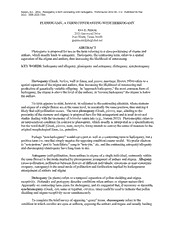
Plesiogamy, a term contrasting with herkogamy PDF
Preview Plesiogamy, a term contrasting with herkogamy
PLESIOGAMY, A TERM CONTRASTING WITH HERKOGAMY Guy Nesom L. 2925 Hartwood Drive Fort Worth, Texas 76109 [email protected] ABSTRACT Plesiogamy proposed for use as the term referring to a close positioning of stigma and is anthers, which usually leads to autogamy. Herkogamy, the contrasting term, refers to a spatial separation of the stigma and anthers, thus increasing the likelihood of outcrossing. KEY WORDS: herkogamy and allogamy, plesiogamy and autogamy, dichogamy, synchronogamy Herkogamy (Greek herkos, wall or fence, and gamos, marriage; Brown 1956) refers to a spatial separation of the stigma and anthers, thus increasing the likelihood of outcrossing and common production of genetically variable offspring. In "approach herkogamy," the most form of herkogamy, the stigma above the level of the anthers: in "reverse herkogamy" the stigma below is is the anthers. No term appears to exist, however, in reference to the contrasting situation, where stamens and stigma of a single flower are at the same level, in essentially the same position, thus making it likely that self-pollination occurs. The term plesiogamy (Greek, plesios, near, alluding to the proximity of the stamens and stigma) is proposed here for this arrangement and is used in several studies dealing with the taxonomy ofMimulus sensu lato (e.g., Nesom 2012). Plesiomorphic refers to an unspecialized condition (in contrast to plesiogamy, which usually interpreted as a specialization), is but the word itself (Greek, plesios, near, morphe, form) intends to convey the sense of nearness to the original morphological form, primitive. i.e., Perhaps "non-herkogamy" would serve just as well as a contrasting term to herkogamy, but a We positive term (vs. one that simply negates the opposing condition) seems useful. prefer electron to "non-proton," past to "non-future," yang to "non-yin," etc, and the contrasting autogamy/allogamy and chasmogamy/cleistogamy have long been in use. Autogamy (self-pollination, from anthers to stigma of a single individual, commonly within the same flower) the mode implied by plesiogamous arrangment of anthers and stigma. Allogamy is (cross-pollination, pollination between flowers of different individuals; synonyms or near-synonyms exogamy, xenogamy) the usual mode of pollination and fertilization implied by herkogamous is ' anthers and stigma. Dichogamy (in plants) refers to a temporal separation of pollen shedding and stigma receptivity. Protandry and protogyny describe conditions when anthers or stigmas mature first. Apparently no contrasting term exists for dichogamy, and suggested that, if necessary or desirable, it's synchronogamy (Greek, syn, same or together, chronos, time) could be used to indicate that pollen shedding and stigma receptivity occur simultaneously. To chasmogamy complete the brief survey of opposing "-gamy" terms, refers to the condition in which corollas are open at anthesis, exposing the anthers and stigma and usually leading Nesom: Plesiogamy and herkogamy 2 Cleistogamy refers to corollas that are closed at anthesis, strongly correlated, with g. self-pollination. — Geitonogamy —(Greek, geiton, neighbor) is another related term. It refers to the pollination by insects or by wind of a flower with the pollen from another flower on the same plant. The result of geitonogamy genetically similar to autogamy. is ACKNOWLEDGEMENTS Many thanks to Beryl Simpson. Steve Weller, and Michelle Dudash for helpful comments. LITERATURE CITED Brown, R.W. 1956. Composition of Scientific Words (rev. ed.). Smithsonian Institution Press, Washington, DC. USA Nesom, G.L. 2012. Taxonomy of Erythranthe sect. Simiola (Phrymaceae) in the and Mexico. Phytoneuron 2012-40: 1-123.
